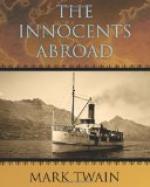We had water batteries and forts on both sides of the Hellespont, flying the crimson flag of Turkey, with its white crescent, and occasionally a village, and sometimes a train of camels; we had all these to look at till we entered the broad sea of Marmora, and then the land soon fading from view, we resumed euchre and whist once more.
We dropped anchor in the mouth of the Golden Horn at daylight in the morning. Only three or four of us were up to see the great Ottoman capital. The passengers do not turn out at unseasonable hours, as they used to, to get the earliest possible glimpse of strange foreign cities. They are well over that. If we were lying in sight of the Pyramids of Egypt, they would not come on deck until after breakfast, now-a-days.
The Golden Horn is a narrow arm of the sea, which branches from the Bosporus (a sort of broad river which connects the Marmora and Black Seas,) and, curving around, divides the city in the middle. Galata and Pera are on one side of the Bosporus, and the Golden Horn; Stamboul (ancient Byzantium) is upon the other. On the other bank of the Bosporus is Scutari and other suburbs of Constantinople. This great city contains a million inhabitants, but so narrow are its streets, and so crowded together are its houses, that it does not cover much more than half as much ground as New York City. Seen from the anchorage or from a mile or so up the Bosporus, it is by far the handsomest city we have seen. Its dense array of houses swells upward from the water’s edge, and spreads over the domes of many hills; and the gardens that peep out here and there, the great globes of the mosques, and the countless minarets that meet the eye every where, invest the metropolis with the quaint Oriental aspect one dreams of when he reads books of eastern travel. Constantinople makes a noble picture.
But its attractiveness begins and ends with its picturesqueness. From the time one starts ashore till he gets back again, he execrates it. The boat he goes in is admirably miscalculated for the service it is built for. It is handsomely and neatly fitted up, but no man could handle it well in the turbulent currents that sweep down the Bosporus from the Black Sea, and few men could row it satisfactorily even in still water. It is a long, light canoe (caique,) large at one end and tapering to a knife blade at the other. They make that long sharp end the bow, and you can imagine how these boiling currents spin it about. It has two oars, and sometimes four, and no rudder. You start to go to a given point and you run in fifty different directions before you get there. First one oar is backing water, and then the other; it is seldom that both are going ahead at once. This kind of boating is calculated to drive an impatient man mad in a week. The boatmen are the awkwardest, the stupidest, and the most unscientific on earth, without question.




